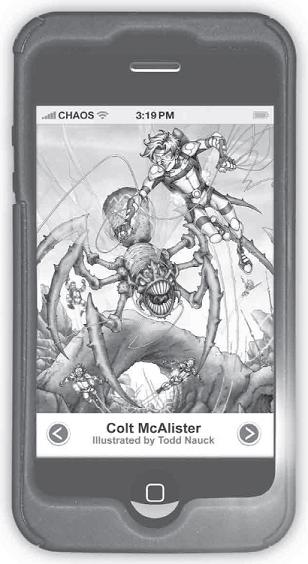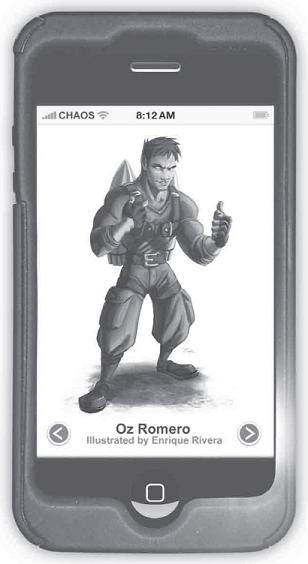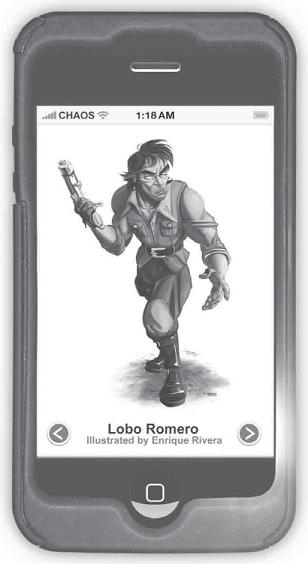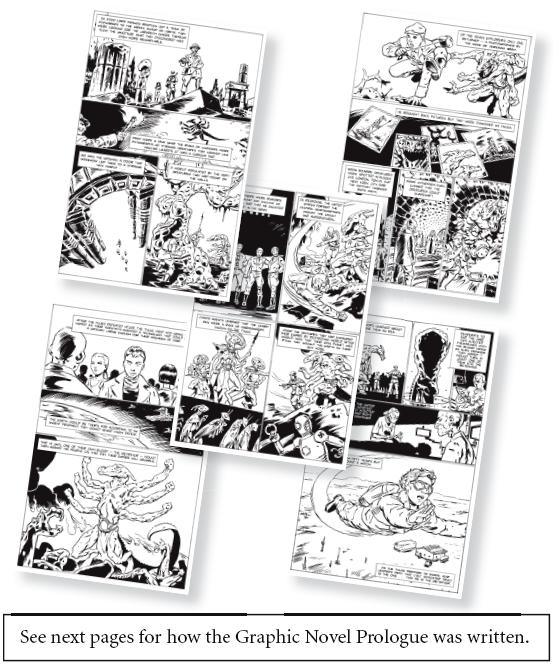Alienation (29 page)

////
COMING JANUARY 2012
////
Book 3 in the C.H.A.O.S. Trilogy








By Jon S. Lewis
I
t's exciting to see how popular graphic novels have become. I grew up on comic books. The moment my parents plopped that allowance money into my hand, I'd hop on my bike and head over to the dime store where there was a spinner rack stuffed with
Action Comics, Fantastic Four, The Amazing Spider-Man, Justice League of America
, and tons more. I was able to buy five comics each week, and I'd stand there for hours thumbing through each title and wondering how I was going to narrow my choices. It wasn't easy. Eventually I'd make it home where I'd run to my bedroom, shut the door, grab a stack of paper, a pencil, and black pen, and then I'd start drawing my favorite panels. More often than not, it featured Benjamin Jacob Grimm, a.k.a. The Thing (who was also on my lunchbox).
My purchasing habits haven't changed much, but instead of riding my bike to the nearest dime store, I drive to Greg's Comics. I still spend hours poring over the amazing art, and I've learned to appreciate the storytelling of not just the words but the images as well.
I've been lucky enough to write for DC Comics, which has been a childhood dream come true. My editor, Shannon Eric Denton, helped me understand the difference between writing a novel and writing a comic book. In traditional prose, writers have a lot of real estate to work with. Most novels end up in the 65,000-90,000 word range, which is usually somewhere between 250-400 pages. In a comic book, there are only 22 pages.
Writing a comic book must be easier, right? I mean, after all, it's way shorter. But there's a catch. You have to tell an entire story in those 22 pagesâthe same story that you'd tell in an entire novel. Oh, and you can't write any descriptive text. All you get is dialogue. Still think it's easier?
Writing comic books is a fantastic exercise for writing traditional prose, because it teachers you the economy of words. In today's headline society, few of us read the newspaper from front-to-back (let alone a physical newspaper). We're so busy that we only have time to read the headlines. That's why novels need to grab our attention right awayâand they can't slow down. Once a reader gets bored, he's not going to come back and finish it.
Books need to be tight. That means cutting the fluff. Writing comic books teaches you how to write an exciting, complete story with an extremely limited word count. It also forces you to make sure your dialogue is strong. A great way to test dialogue is to read it out loud. Or you could even give the pages to a couple of friends and listen to them read it out loud. If the dialogue sounds goofy or unnatural, it probably is. Then you can go back in and tweak it until it sounds like something someone would actually say.
My favorite component of writing comic books and graphic novels is that it's truly a collaborative process. You work with not just an editor, but with a team of artists: a penciller, inker, colorist, and a letterer. Writing a novel is solitaryâlike living alone in a cave on top of a remote mountain peak. With comic books, you have an entire team to bounce ideas back and forth, and it's energizing!
You end up working closest with the penciller. He's the one who turns your words into images. Some people operate in what's been coined “The Marvel Method.” It started in the early days at Marvel Comics, where Stan Lee would come up with a story idea, hand it off to an artist, and that artist would flesh into 22 pages of amazing illustrations. When he was done, Stan would go back and fill in the word balloons with dialogue and voila!
I prefer a more traditional method. I write the story and break it into panels (the squares and rectangles that frame all the illustrations on each page). I break out the dialogue and write notes about what I envisioned for the illustrations. It's a lot like a director on a movie set. I talk about things like camera angles (close up, wideshot, aerial view, etc.), and then I explain backgrounds and which characters should be in each panel. But that's not always what makes it to the final page.
Comic book artists are some of the best illustrators and storytellers in the world, and sometimes they have a vision for the art that's different from mine. And you know what? I love it! I'm a firm believer that differing views not only make this world interesting, but they bring about greatness. I love to be challenged, because it forces me to consider that there might be a better way of doing something. That's true collaboration, and when someone challenges you in life it shows they have passion.
Once the penciller and I have agreed on the panel layouts, he starts to draw. When his drawings are approved, the inker goes over the pencils to finalize those bold lines and powerful shadows. Then it's up to the colorist to make it all pop. When he's done, the letterer goes in and creates the word balloons.
For the prologue to
Alienation
, I was lucky enough to work with Mike Dubisch. He not only did the pencils, but he inked and lettered the pages as well. That's real talent!
For those of you who want to become writers, comic books and graphic novels are an exciting format. In fact, we've included the manuscript that Mike and I worked from. Now you have an insider's edge to creating your own stories.

